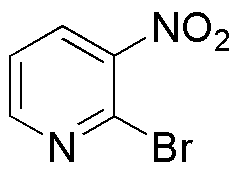2-Bromo-3-nitropyridine is widely utilized in research focused on:
- Synthesis of Pharmaceuticals: This compound serves as a key intermediate in the synthesis of various pharmaceuticals, particularly in the development of antibacterial and antifungal agents.
- Organic Electronics: It is used in the fabrication of organic electronic materials, contributing to the development of more efficient organic light-emitting diodes (OLEDs) and organic solar cells.
- Agrochemicals: The compound plays a significant role in the formulation of agrochemicals, enhancing the efficacy of pesticides and herbicides to improve crop yields.
- Research in Material Science: It is employed in material science research for creating new polymers and materials with unique properties, aiding in advancements in nanotechnology.
- Biochemical Applications: The compound is utilized in biochemical assays and studies, helping researchers understand enzyme interactions and cellular processes.
General Information
Properties
Safety and Regulations
Applications
2-Bromo-3-nitropyridine is widely utilized in research focused on:
- Synthesis of Pharmaceuticals: This compound serves as a key intermediate in the synthesis of various pharmaceuticals, particularly in the development of antibacterial and antifungal agents.
- Organic Electronics: It is used in the fabrication of organic electronic materials, contributing to the development of more efficient organic light-emitting diodes (OLEDs) and organic solar cells.
- Agrochemicals: The compound plays a significant role in the formulation of agrochemicals, enhancing the efficacy of pesticides and herbicides to improve crop yields.
- Research in Material Science: It is employed in material science research for creating new polymers and materials with unique properties, aiding in advancements in nanotechnology.
- Biochemical Applications: The compound is utilized in biochemical assays and studies, helping researchers understand enzyme interactions and cellular processes.
Documents
Safety Data Sheets (SDS)
The SDS provides comprehensive safety information on handling, storage, and disposal of the product.
Product Specification (PS)
The PS provides a comprehensive breakdown of the product’s properties, including chemical composition, physical state, purity, and storage requirements. It also details acceptable quality ranges and the product's intended applications.
Certificates of Analysis (COA)
Search for Certificates of Analysis (COA) by entering the products Lot Number. Lot and Batch Numbers can be found on a product’s label following the words ‘Lot’ or ‘Batch’.
Numéro de catalogue
Numéro de lot/série
Certificates Of Origin (COO)
This COO confirms the country where the product was manufactured, and also details the materials and components used in it and whether it is derived from natural, synthetic, or other specific sources. This certificate may be required for customs, trade, and regulatory compliance.
Numéro de catalogue
Numéro de lot/série
Safety Data Sheets (SDS)
The SDS provides comprehensive safety information on handling, storage, and disposal of the product.
DownloadProduct Specification (PS)
The PS provides a comprehensive breakdown of the product’s properties, including chemical composition, physical state, purity, and storage requirements. It also details acceptable quality ranges and the product's intended applications.
DownloadCertificates of Analysis (COA)
Search for Certificates of Analysis (COA) by entering the products Lot Number. Lot and Batch Numbers can be found on a product’s label following the words ‘Lot’ or ‘Batch’.
Numéro de catalogue
Numéro de lot/série
Certificates Of Origin (COO)
This COO confirms the country where the product was manufactured, and also details the materials and components used in it and whether it is derived from natural, synthetic, or other specific sources. This certificate may be required for customs, trade, and regulatory compliance.


